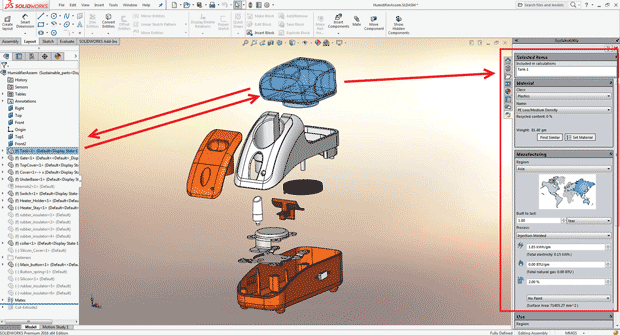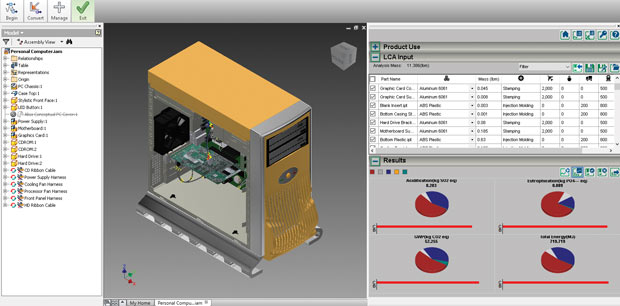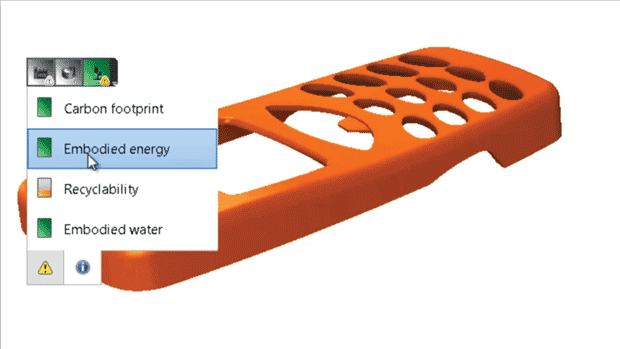
SOLIDWORKS Sustainability has lifecycle assessment, material selection and end of life considerations built directly into the software. Image courtesy of SOLIDWORKS.
Latest News
July 1, 2016
There is a lot of design that can go into one package. And, to create a good design, engineers must create something that is not only structurally sound, but also aesthetically appealing to the average consumer. To meet these goals requires the use of design, simulation and now lifecycle applications as integrated engineering workflows expand to include sustainable design processes.
According to a report by Mordor Intelligence, the current market for global green packaging is expected to reach $274.15 billion by the year 2020. This includes packaging that is recyclable, reusable or degradable.
 SOLIDWORKS Sustainability has lifecycle assessment, material selection and end of life considerations built directly into the software. Image courtesy of SOLIDWORKS.
SOLIDWORKS Sustainability has lifecycle assessment, material selection and end of life considerations built directly into the software. Image courtesy of SOLIDWORKS.“We’re seeing more green options in packaging—recyclable, reusable and degradable—as manufacturers reduce source material creating lighter primary and secondary packaging, thus reducing waste,” says Paula Feldman, director of Business Intelligence PMMI, an association for packaging and processing technologies. “We expect this practice to increase in the coming years as CPGs (consumer packaged goods providers) strive to meet consumer demand.”
Adam Gendell, senior manager of the Sustainable Packaging Coalition (SPC) says packaging has to be part of the conversation about using natural resources in a sustainable way. “Products almost always carry higher levels of environmental, economic and social implications,” he says. “For the protection of products, it’s essential to use the right amount of packaging in order to maximize the benefits of the product and minimize its impacts.”
Ultimately, the goal is to create packaging that not only has an efficient design and manufacturing process, but can also have a low environmental impact once it leaves the factory. This can lead to different design considerations up front.
“You’re looking at things that are often not designed to last very long,” says Dawn Danby, senior sustainable design program manager at Autodesk. “That question of the lifetime of a product is really different. You’re also looking at really wanting to recover as much valuable reusable material as possible.”
It’s also about balance, says Gendell. “In all our work we’ve never once come across a situation in which one packaging design option was clearly more sustainable than anything else. Every decision introduces trade-offs. The sustainability community can’t tell industry that any one sustainability characteristic is more important than another, so there are judgment calls to be made,” he explains.
Materials Matter
A primary way to ensure sustainable packaging design is to investigate different material options. But, this can pose challenges for designers because the amount of available materials for green design is often a much smaller pool.
“You’re trying to think of materials that are inherently low impact,” says Prashant Jagtap, president and CEO of Trayak, a product sustainability consulting and software provider. “There’s also the idea of using materials that are bio-renewable, [such as] plastics from ethanol or paper from renewable sources.”
To help with material selection, Danby says Autodesk offers the Eco Materials Adviser. Integrated into Inventor, this add-on can help address environmental requirements with access to Granta Design materials data. In the packaging world, it’s an interesting opportunity to identify where the points of recycling are, according to Danby. “The palette of materials is smaller. The Eco Materials Adviser will give [users] access to many, many materials and a lot of detail,” she says.
However, it’s important to look at considerations beyond materials—application is also key. “The same product could require more of one packaging material type than another to get the same performance characteristics. Packaging materials are rarely interchangeable on a one-to-one basis. Put in the proper context of a specific packaging option, though, winners can be identified,” says Gendell.
A Holistic View
Just like traditional design, engineers must consider how a product moves throughout the entire design-to-manufacture process. Considering the lifecycle is also a way for designers to identify pain points in the sustainable design process. “A lifecycle view of packaging tells us there are many areas that should be improved,” says Gendell. “Industry has shifted toward a more comprehensive understanding of packaging, and the packaging sustainability improvements are evident.”
When it comes to looking at the entire lifecycle of a sustainable design, it’s necessary to implement software that can offer extended lifecycle assessment (LCA), which goes beyond simplified data management. “The traditional PLM is about developing products and launching products or packages. But their focus is mainly on time to market or innovation and just trying to do things efficiently,” says Jagtap. “Where as sustainability, on top of focusing on certain parts [of PLM] you’re also focusing on what type of materials and you need to go much more upstream than traditional PLM to try and understand the impact [of a package].”
 EcoDesigner, from Trayak, is built into a CAD system to offer environmental analysis early in the design cycle. Image courtesy of Trayak.
EcoDesigner, from Trayak, is built into a CAD system to offer environmental analysis early in the design cycle. Image courtesy of Trayak.It’s also important to consider the package’s end of life, something that might not always be built into current software offerings.
Using lifecycle analysis is also another way to identify optimal designs early within the design process. “Running a lifecycle assessment on your design concepts as you go helps make the best decisions on material selection, design for recycling, minimized energy consumption and end of product life use that will identify the design with the least environmental impact,” says Eric Leafquist, senior product manager at SOLIDWORKS.
Tools of the Trade
While a part of developing sustainable packaging is knowing how to implement the right design techniques, software can also play a large role. Giving users access to tools so they can consider sustainability earlier in the design process is a major effort of Autodesk’s Sustainability Group, Danby explains. “It means they’re doing much more integrated thinking,” she says.
Along those lines, the SPC has developed COMPASS—in partnership with Trayak—to provide cradle-to-grave analysis of environmental impact. “A design team can use COMPASS to compare design options and learn relative intensities of environmental impacts like greenhouse gas emissions and water consumption,” says Gendell. The organization also has websites that can help designers get an overview of what sustainable packaging entails and how to understand recyclability.
In addition to COMPASS, Trayak offers a host of software for creating sustainable designs all across the workflow. The offerings from Trayak—EcoDesigner, EcoImpact, EcoLabel and EcoScore—are all part of a main portfolio, notes Jagtap. This is “to help mainstream sustainability,” he says. EcoDesigner is embedded into the CAD system to bring the day-to-day designer access to environmental impact analysis and incorporate design-for-environment principles. “What we’re trying to do is let the CAD system be the main place [for sustainable design],” Jagtap says.
Autodesk also offers Trayak’s EcoDesigner software for the Autodesk Inventor ecosystem. EcoDesigner LCA provides designers with the insight to quantify the effects of material decision, sourcing options and manufacturing processes early in the upstream design stages.
 With Moldflow Design, users can gather environmental impact markers within the 3D modeling interface. Image courtesy of Autodesk.
With Moldflow Design, users can gather environmental impact markers within the 3D modeling interface. Image courtesy of Autodesk.SOLIDWORKS also brings its features directly into the design stage with the availability of an LCA tool, environmental impact dashboard, baseline measurement, material database search capability and customizable reports. “Having SOLIDWORKS Sustainability [and other analysis tools] fully integrated inside SOLIDWORKS enables very fast iterations of design-analysis-design that speeds the refinement process for the engineer,” Leafquist says. “It is the fastest way to work without the need for export-then-import to other, separate tools.” Recently, the company has integrated these tools into SOLIDWORKS Premium, added more materials and updated the user interface.
While Autodesk doesn’t have specific branded tools for sustainable packaging design, Danby says that the company is looking to help its users leverage the current offerings of Inventor and Fusion 360 to get in a greener design mindset. “Really what we’re looking at is ‘how do we encourage people to use the tools that we have?’” she says.
One initiative is Autodesk’s Sustainability Workshop, an online research to help teach engineers the practice of sustainability in engineering and design. There’s a lot that can be done with the existing simulation capabilities that are now available, Danby says.
Ultimately, what these organizations are seeking to do is soften the learning curve for sustainable packaging and product design—especially because it’s gaining more traction within the design industry. “In many ways, sustainability is similar [to finite element analysis],” says Jagtap. “You could have lifecycle experts, but we’re trying to bring that deep expertise, knowledge and analysis to the engineer much earlier in the design cycle.”
More Info
Subscribe to our FREE magazine, FREE email newsletters or both!
Latest News
About the Author
Jess Lulka is a former associate editor for Digital Engineering. Contact her via [email protected].
Follow DE





